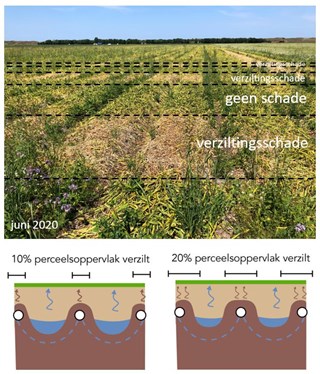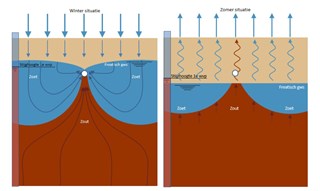Damage due to salinisation can be seen in the field in Texel
Crop damage above the tile drainage pipes - June 2020
The photo of June 2020 shows crop damage due to salinization above the tile drainage on an agricultural field in Texel, one of the islands of the Netherlands. Last week there was considerable salinization damage due to rising salt into the root zone above the tile drainage. Earlier within Spaarwater (www.spaarwater.com (http://www.spaarwater.com)) it has already been calculated by Acacia Water that this type of crop damage can occur in the field and what the economic damage is for the farmer. Conversations with the farmers on the island show that this type of crop damage is seen more often, and is nowadays already recognized as salinization damage.
The photo shows the damage with an explanation in the graphic below. There a percentage of damage on the field parallel to the tile drainage pipes, while in between there is no damage (yet). The solution to this problem could be anti-salinization drainage a.k.a. system specific tile drainage, read about it in our article published in H20 online (https://www.h2owaternetwerk.nl/vakartikelen/anti-verziltingsdrainage-een-waardevolle-zoetwatermaatregel-op-perceelsniveau) (in Dutch).
The freshwater lens
Agriculture in areas with saline groundwater is possible thanks to thin fresh rainwater lenses that ”float” on salt groundwater in between tile drainage pipes, also known as the freshwater lens. The depth of the fresh - saltwater interface of the freshwater lenses between the drains varies with time, depending on the amount of precipitation and evaporation. As there is more evaporation, the lens shrinks, and the more precipitation infiltrates, the more the lens can grow.
Read more about freshwater lenses in the Spaarwater reports (http://www.spaarwater.com/pg-27227-7-101962/pagina/nieuwe_resultaten.html#!section).
 verziltingschade Texel 2020
verziltingschade Texel 2020
 winter en zomer situatie neerslaglens
winter en zomer situatie neerslaglens